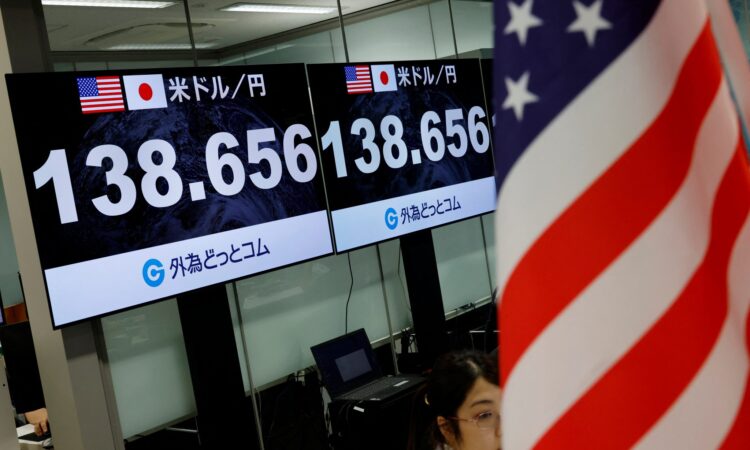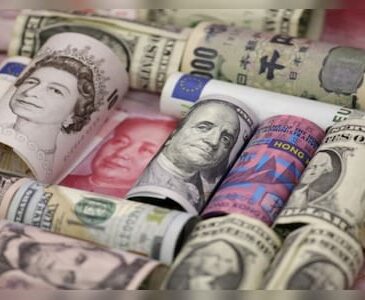
Author: Michael G Plummer, Johns Hopkins University
The United States has been instrumental in leading the post-war global economic system which it helped create. Yet its economic weight has declined over time and strategic competitors in emerging markets are calling for change, including possible ‘decoupling’. Some suggest that the US dollar’s days as the central global currency are numbered.

The US dollar’s role continues to be central to the functioning of the international financial system. The Bank of International Settlements estimates that the US dollar is involved in almost 90 per cent of foreign exchange transactions and accounts for 85 per cent of transactions in spot, forward and swap markets. Half of global trade and three-fourths of Asia-Pacific trade are denominated in US dollars.
The share of the US dollar held as official foreign exchange reserves has fallen from 61.5 per cent in 2012 to 58.4 per cent in 2022, but so has the euro (from 24.1 per cent to 20.5 per cent) and the renminbi share remains under 3 percent. Foreign currency debt denominated in US dollars has remained at about 70 per cent since 2010. The Fed’s Index of International Currency Usage has also remained constant at about 68 per cent.
Dissatisfaction with the dominant role of the US dollar emerges periodically, usually corresponding to a major shift in the global economy or an international crisis. For example, when Japan emerged as an ‘economic juggernaut’ in the late 1980s, many thought the yen would and should take on a much bigger role. It didn’t. Today, the yen only constitutes about 5 per cent of foreign exchange reserve holdings. Even greater expectations arose when the euro was created, but outside of Europe the currency has not taken on a larger role.
The same is true for the major shock of China’s extraordinary rise over the past generation. The Index of Foreign Currency Usage gives the renminbi a 3 per cent share, half that of the British pound and two-fifths that of the Japanese yen. It turns out it is very difficult to dethrone the US dollar.
Criticism of this outsized role for the US dollar has been more vocal in recent years, particularly in light of geopolitical tensions. By controlling the US dollar, the US government can yield a very big stick through, for example, blocking access to the SWIFT system of cross-border interbank transfers, as in the case of the Russian war on Ukraine.
It is no coincidence that countries who have been the most vocal about reducing the role of the US dollar in the global financial system tend to be geopolitical rivals of the United States. But some countries who have a less prickly relationship with the United States, including Malaysia and Brazil, have also been pushing for diversification. There is even a plan to resurrect the idea of an Asian Monetary Fund, first proposed by Japan during the Asian Financial Crisis.
Recent sanctions on Russia have led to its dealing more in renminbi and other currencies, highlighting the ability of the United States to apply pressure through its control of international financial markets, leaving other countries exposed. In 2023, Bolivia became the third Latin American country after Argentina and Brazil to use the renminbi in settling trade transactions. Even Saudi Arabia is considering using the renminbi in oil trade with China.
But it is unlikely that there will be any major shift soon. The US economy is not only the largest economy in the world but is also diversified, dynamic, innovative and relatively flexible. While its share of global GDP has fallen, this is due to rising shares of emerging markets. The US share in total OECD GDP has actually risen from 37 per cent in 2000 to 43 per cent in 2023.
The Chinese financial system is still relatively closed and the Chinese government is unlikely to be willing to free up its financial markets in the short- or medium-term — at least not under the current administration, whose priorities are moving in the opposite direction. If countries wish to avoid the US dollar because of potential sanctions, they probably would not be comfortable being exposed to China either, as it also applies sanctions and has been accused of ‘debt-trap diplomacy’, or other OECD countries whose approaches to sanctions generally dovetail that of the United States.
While politics in the United States are unpredictable and increasingly fraught, the government is stable and, despite the deteriorating fiscal policy outlook, the reputation of its monetary authority is solid. International actors continue to consider it a safe and secure place to invest.
The US government has been able to sustain large trade deficits over time — the result of excess net national savings in the global economy and its own excess public and private debt creation. Many other governments would find this to be a political non-starter. China, for example, has not had a current account deficit since its dual currency system was unified in 1994.
Loud calls to replace the US dollar appeal more to local domestic constituencies than to international financial actors. The global system gains from having an internationally accepted currency like the US dollar as a medium of exchange, unit of account and store of value. But its role will diminish at the margin at a rate that will be the function of exogenous factors, such as changes in the international marketplace, and endogenous factors, such as how the United States faces its financial and trade challenges.
Michael G Plummer is Director at SAIS Europe and Eni Professor of International Economics at Johns Hopkins University.


